
Dive into the aquatic world of awe-inspiring piscatorial wonders as we explore and review some of the most exquisite fish sporting sizeable craniums. The ocean’s depth holds secrets of beauty, form, and diversity, and today, we surface a niche of nature’s artistry through the lens of those captivating water dwellers with prominent foreheads. Join us on this visual voyage as we sail from tank to tank, describing, admiring, and grading these underwater titans of charm. Here is your exclusive insider peek into the stunning world, brimming with vibrant scales and personality – this will not just be another fish tale!
Defining the Aquatic Crown
Let’s plunge into the depths where certain fish turn heads, not just with their colors or fins, but with their distinctive, oversized noggins. In the underwater world, having a big head is more than just a quirky trait; it’s an evolutionary masterpiece that’s celebrated across different species. Whether it’s a symbol of status or simply a practical asset for survival, these fish with their pronounced craniums are a marvel to behold. We’re beginning our journey by examining what sets these finned monarchs apart, from the unique anatomy that gives them their notable profiles to the cultural significance that makes them revered by fish enthusiasts around the globe.
Anatomical Attributes of Big-Headed Fish
Big-headed fish are a curious and fascinating group in the aquatic world. What sets them apart is not just the size of their heads but also their brain-case or cranial region, which is often pronounced and distinctive. This feature is not just for show, as it serves various purposes, such as housing a larger brain, specialized muscles, or unique organs that provide these fish with advantages in their underwater environments.
Their anatomy can come with some interesting adaptations. For instance, some species have developed enlarged nuchal humps – fatty deposits on their heads which they use for various reasons, from attracting mates to asserting dominance. Others might have extravagant features like fluid-filled bubbles or intricate headgear resembling a crown. These peculiar traits contribute to their survival and have charmed fish enthusiasts for centuries.
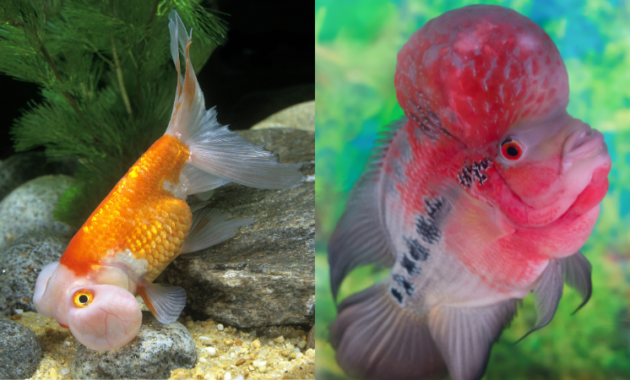
Symbolism & Significance in Various Cultures
The aquatic realm is rich in lore and symbolism, with big-headed fish usually taking center stage in many cultures. These fish are often associated with abundance and prosperity, reflecting the belief that a large head symbolizes intelligence and good fortune. In Chinese culture, for example, the lionhead goldfish is considered a sign of luck and is a staple during celebrations like the Lunar New Year.
Across the ocean, in Japan, the Koi fish, known for its impressive size and head, is celebrated in annual festivals. The Japanese admire these fish for their strength and determination, as they’re known to swim upstream against the current. To them, a pond full of Koi is a living tapestry of victory and perseverance. Indeed, from one corner of the globe to another, fish with grandiose heads carry tales and traditions that ripple through time.
Attraction Factors: What Makes Them Stand Out?
The allure of big-headed fish lies not just in their sizeable skulls, but also in the unique charm they bring to the aquatic scene. Bold brows and eye-catching profiles set these swimmers apart from their streamlined counterparts. It’s these very traits that draw tanks closer, inviting a second glance and a moment of appreciation for their distinct beauty.
Imagine walking past an aquarium and having your gaze arrested by a fish that looks, well, unconventional. It’s the peculiar shapes and vivid patterns that often capture our attention. Whether it’s the playful wobble of a bubble eye or the royal finnage of an oranda, these attributes go beyond aesthetics. They tell a story of survival, adaptation, and the rich tapestry of biodiversity beneath the waves.
Fish with Big Heads: Top Contenders for the Aquatic Throne
Let’s meet the superstars of the aquarium world, the ones with the grandest of noggins! Each of these finned friends not only has a personality of its own but also an incredible presence, marked by their oversized, ornate heads. We’re putting the spotlight on a select group that could easily claim the throne of aquatic beauty. Get ready to be introduced to a lineup that’s both rare and regal in the fish fandom.
Oranda Goldfish: The Watery Royalty
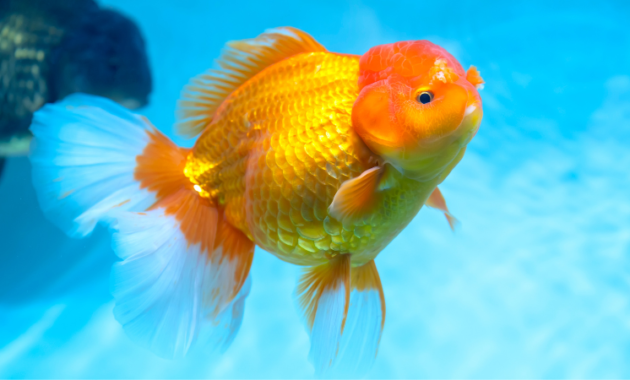
If there’s a regal presence in the world of aquatics, it’s the Oranda Goldfish. These beautiful creatures have a distinctive, bubbly cap on their heads known as the ‘wen’. The wen is what sets them apart and gives them that fancy, royal look, just like a crown sitting atop their charming little faces. This cap grows throughout their life, often reaching impressive proportions that command attention.
Not only do their heads make them stand out, but Oranda Goldfish also come in a palette of delightful colors. Ranging from oranges and reds to more unusual shades like blues and blacks, these fish are like swimming jewels. They gracefully glide through the water with their flowing, delicate fins that fan out like the gowns of court dancers. Every move they make is a silent dance, celebrating the very art of being picturesque and serene.
Flowerhorn Cichlid: A Floral Spectacle
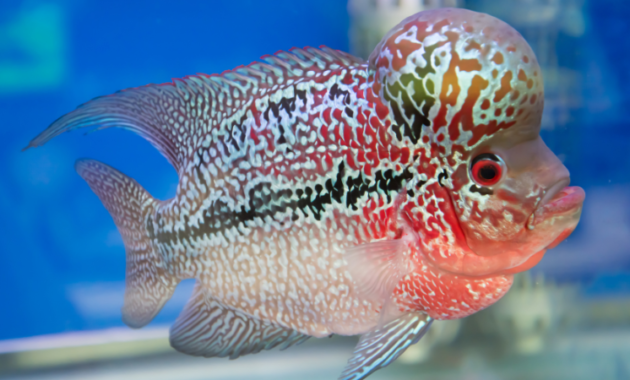
The Flowerhorn Cichlid emerges as a true masterpiece of underwater artistry. With their vibrant colors and the distinctively large, flowery-shaped nuchal hump on their heads, these unique creatures can easily steal the spotlight in any aquarium. Their vivid presence is like a living, swimming painting that never fails to captivate onlookers. What really sets them apart is their interactive behavior; they’re known to display a charismatic personality, often connecting with their owners in ways that few fish can.
Caring for these water-bound beauties is both rewarding and demanding. They require spacious tanks to accommodate their size and the playful energy they exude. Their diet, comprising both meat and plant-based foods, along with their sensitivity to water conditions, means aquarists need to be diligent and attentive. However, the effort pays off substantially as a well-cared-for Flowerhorn will boast brighter colors and a more pronounced head growth, both signs of good health and happiness in these flamboyant swimmers.
Lionhead Goldfish: The Mane Event
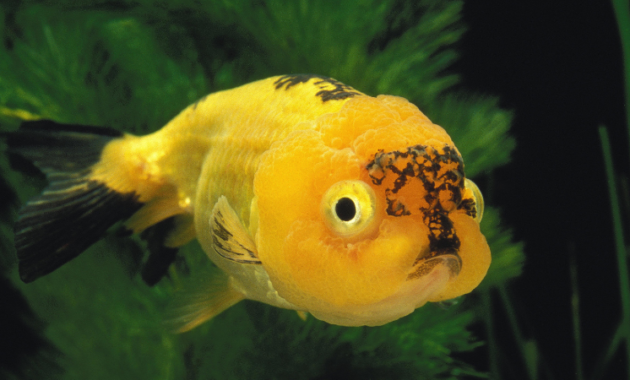
Imagine a fish with a luxurious mane, much like a lion’s, and you’ve got the Lionhead Goldfish. This stunning breed is often the center of attention in any aquarium. Their trademark feature is a fleshy, raspberry-like growth on top of their head, which is lovingly referred to as the “wen.” This wen begins to develop when they’re just a few months old and continues to bloom as they grow.
These velvety-finned beauties come in a variety of colors, ranging from deep oranges to shimmering golds, and sometimes even a mix of calico patches. Its lack of dorsal fin contributes to its distinct, rounded body shape, making it a graceful swimmer. The Lionhead is a true aquatic treasure, perfect for those looking to add a regal touch to their underwater kingdom.
Bubble Eye Goldfish: The Unique Aquatic Globe
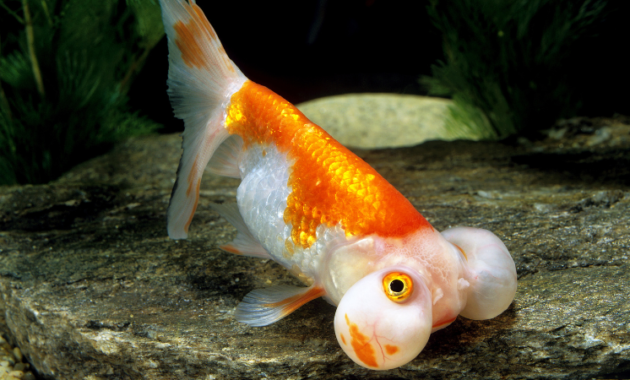
Have you ever seen a fish that looks like it’s carrying two little water balloons on the sides of its head? Meet the Bubble Eye Goldfish, a sight to behold in the aquatic community! This fascinating breed has two large, fluid-filled sacs under its eyes, creating a distinctive appearance that can’t be missed.
These bubbles aren’t just for show; they are a product of careful breeding. But be extra careful, as their delicate bubbles can burst. A tank for Bubble Eye Goldfish should be free of sharp objects and decorations to keep these living gems safe and sound. They glide through the water with a gentle grace, truly the unique globes of the fish world.
Judging the Jewels of the Deep
Ever wondered how to tell which fish in your aquarium are true underwater beauties? It’s not just about vibrant colors or fancy fins. In the world of big-headed fish, specific criteria can turn an ordinary swimmer into a submerged superstar. We’ll dive into what makes these fish stand out, evaluate the charm and challenges of popular species, and discuss how to keep them healthy and handsome. Let’s take a moment to appreciate the striking details and wellness of these captivating creatures.
Criteria for Reviewing Beauty in Fish
When we plunge into the task of evaluating our finned friends, the concept of beauty can be pretty subjective, but there are some standards by which enthusiasts often abide. Fish fanciers typically look at the colors and patterns of these swimmers, seeking out vibrant, distinctive hues and unique markings that catch the eye. It’s not just about brightness, though – the richness and depth of color matter too, and how these shades shimmer and change under the light.
Another key factor is the shape and symmetry of the fish, including its pronounced head. A big head may be a badge of beauty, but it should be well-proportioned to the rest of the body, maintaining a harmonious balance. The overall health and vitality of the fish also come into play; clear eyes, smooth swimming, and an active demeanor often mean the fish is both healthy and handsome. So when setting these gentle giants against each other, it’s a mix of color, charisma, and condition that we’re really looking at.
Highlights and Downfalls of Popular Species
Not all fish are created equal, especially when it comes to their royal-looking heads. Oranda Goldfish are like the monarchs of the aquarium, flaunting their distinctive “wen” or head growth that resembles a soft, fluid crown. They grab attention with a diverse palette of colors and the friendly personalities to match. But it’s not all regal splendor; these beauties can be prone to infections if their fancy wen isn’t cared for properly.
Meanwhile, the Flowerhorn Cichlid brings its unique flair to the mix with a vibrant nuchal hump known as a ‘kok’. This stunning feature is like a badge of honor, enhancing with age and good health. However, they command a vast territory and can get territorial, making them less than ideal for a peaceful community tank. Additionally, their need for specific water parameters means only seasoned aquarists should take on their care.
Maintenance and Care for Optimal Health and Aesthetics
Caring for these aquatic marvels is not just about keeping them afloat; it’s a blend of science and art. Water conditions play a vital role in the health and beauty of your fish. For instance, maintaining the right pH levels, ensuring the water is well-filtered, and keeping it at the proper temperature are the basics that can’t be ignored. Regular water changes are necessary to rid the tank of waste by-products and to replenish essential minerals.
Aside from water quality, diet is the cornerstone of vibrant health and aesthetics for big-headed fish. A balanced diet rich in variety promotes stunning coloration and supports the development of their remarkable cranial features. Live, frozen, and specially-formulated feed can provide the nutrition they need. And remember, the beauty of your fish is often a reflection of their overall well-being, so arm yourself with knowledge, and these floating masterpieces will thrive under your care.
Aquarists’ Perspectives: Expert Opinions
When it comes to understanding the allure and care of strikingly unique fish, there’s no better source than the experts themselves. We reached out to seasoned aquarists to get the scoop on what makes these large-headed swimmers more than just a pretty face in the underwater world. Their insights shed light on the importance of these majestic creatures in competitions and the dedicated effort it takes to breed them for their captivating aesthetics. Here’s a treasure trove of wisdom from those who know these fish best!
Interviews with Renowned Fish Enthusiasts
Diving into the minds of those who spend their days surrounded by water wonders, we get a clearer picture of what makes these big-headed beauties so special. Experienced aquarists don’t just view their aquariums as tanks, but as canvases where nature’s artistry is displayed. Through interviews, they share their passion, insights, and the subtle nuances that might escape the average eye. They tell tales of dedication and the joy these fish bring to their lives.
Each enthusiast has a unique story. From tales of their first impressive fish to the challenges they’ve faced breeding and caring for these special species, their experiences are rich with knowledge. Aquarists speak of the nuanced behaviors and personalities that each fish with a sizeable forehead brings to the tank. They emphasize not only the beauty but also the responsibility that comes with keeping such creatures. These interviews offer invaluable advice for anyone looking to dive into the world of caring for these stunning aquatic pets.
The Role of Big Heads in Competitions and Shows
In the world of aquatic shows, the fish with the grandest of noggins often steal the spotlight. It’s in these competitions that the unique characteristics of the more voluptuous cranial residents of our tanks are celebrated. Judges and spectators alike marvel at the most admirable domes, which reflect the fish’s health and the owner’s dedication to their care.
Competitions have specific classes for these heady beauties, where features like size, shape, and color are meticulously assessed. Breeders take great pride in presenting their aquatic pals with perfectly rounded or patterned foreheads. ”The larger and more pronounced the head, the higher the scores,” many enthusiasts would say. It’s a fascinating intersection of natural beauty and human craftsmanship that creates a buzz among the community.
Breeding for Beauty: Efforts and Ethics
Breeding fish with prominent craniums isn’t just about aesthetics; it’s a blend of passion, precision, and responsibility. Aquarists often spend years perfecting the genetics of their fish to achieve the ideal physical traits that characterize the species. But it’s not all about looks—the health and well-being of the fish are just as paramount.
When breeding these underwater beauties, ethical considerations must take center stage. After all, these living creatures depend on breeders for their care. Responsible breeders prioritize traits that don’t compromise the fish’s health or longevity. They strive to create an environment that mimics natural habitats as closely as possible, ensuring the fish lead happy, stress-free lives. It’s a delicate balance between the pursuit of beauty and the duty to provide a nurturing environment.
Imagine a Tank of Titans: Creating Your Own Display
Ever dreamt of showcasing marine aristocrats right in your living room? Imagine an underwater theater where the stars have majestic crowns and glide with a dignified poise that captivates the heart. With the right know-how, creating a home for these distinguished swimmers can be both fulfilling and a visual treat. Let’s dive into setting up an aquarium where each detail accentuates the unique appeal of these regal fish.
Choosing the Right Tank Setup for Big-Headed Fish
The perfect home for your wide-browed swimmers begins with the right tank. You need to ensure there’s plenty of space because these fish aren’t just decorative; they’re active creatures that need room to roam. A spacious tank also helps maintain a clean and healthy environment, as big heads can mean big messes. Focus on tanks that are long rather than tall to give your fish ample swimming area.
When it comes to big-headed fish, filtration can’t be an afterthought. These fish can be messy, so a robust filtration system will keep the water clear and free of waste. Look for filters that offer mechanical, chemical, and biological filtration to cover all bases. But remember, the current shouldn’t be too powerful; these beauties are more about grandeur than speed and might struggle against strong water flow.
Now let’s make their castle a home: Layer the bottom with fine substrate as big-headed fish often enjoy foraging. Avoid sharp-edged decor that could potentially harm their delicate exteriors. Instead, opt for smooth rocks, rounded driftwood, and live plants that offer shelter and add oxygen to the water – your fish will thank you by showing off their vibrant colors and playful antics.
Compatible Tank Mates for Peace and Harmony
When setting up a home for your oversized cranium companions, it’s crucial to think about who they’ll be bunking with. Peace and harmony in your tank don’t just happen—they’re the result of careful planning and knowledge about which fish play nice together. Some fish are like friendly neighbors, while others are the noisy types that can cause a ruckus.
For instance, Oranda Goldfish are pretty chill. They do well with other Goldfish varieties, but steer clear of fin-nippers like Tiger Barbs. Gentle friends like the Rubber Lip Pleco can make great roommates for your Oranda, keeping the environment clean without starting any turf wars. Remember, a peaceful tank is a happy tank, and less stress means healthier, more beautiful fish.
Decorations and Plants to Complement Your Fish
When you’re setting up a tank, choosing the right decorations and plants isn’t just about making it look nice—it’s about creating a comfy home for your fishy friends with large noggins. Plants play a huge role; they not only add a splash of green and a natural vibe, but they also help keep the water clean and provide spots for your fish to hide and chill.
It’s like picking out the best furniture for your living space. You’ll want to go for plants that are hardy and won’t be easily damaged by your big-headed pals. Anubias or Java Fern are solid picks because they’re tough and can handle the occasional fish bump. For decorations, think smooth—rounded caves or driftwood without sharp edges where your fish can explore without risking their impressive foreheads. And let’s not forget lighting! A soft glow can really make those unique fish features and colors pop.
Conclusion
In the aquarium of our hearts, the big-headed fish reign supreme, swimming through their liquid kingdoms with grace and grandeur. This review has offered a glimpse into a world where bulbous is beautiful and size does matter, at least to an extent in the realm of aesthetics. As stewards of these aquatic treasures, let the splendor of their ample domes inspire you and the tender care they need remind you of our connection to every ripple and wave. Whether you’re an aquarist or simply an admirer from afar, may the currents bring these remarkable visions to your memory like a resplendent dream recalled upon waking.
